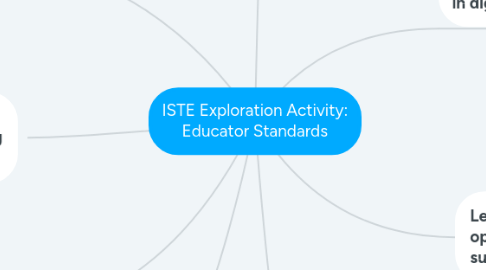
1. Learner: actively builds upon their knowledge and skills in the field
1.1. Ex: reflect on teaching, stay up to date on new strategies, create an interdisciplinary learning experience
1.1.1. Webinars, conferences, virtual learning communities.
2. Learner: improve both themselves and student learning with technology tools
2.1. Ex: blended learning communities, edcamps (conferences), virtual PLNs
2.2. Emerging learning strategies with technology
2.2.1. collaborative learning e.g. google suite, mathalicious, Eudecreations Interactive Whiteboard etc.
3. Collaborator: engage with others to improve practice
3.1. Work with other educators & students to discover new tools and create collaborative, authentic, and hands-on experiences.
3.1.1. Ex: shareable documents, emails, social media.
4. Designer: utilizes best practices to meet the varied learning needs of the students.
4.1. Utilize technology to meet the needs of all students
4.1.1. Ex: targeted learning experiences, blended learning, visuals, altering instruction to maximize engagement.
5. Citizen: encourage participation in digital world
5.1. Blog, discussion boards, classroom websites etc.
5.1.1. Ex: edublog, weebly
5.2. Ex: teacher used to post do-nows and then you would log in and leave a response
6. Leader: seek leader opportunities and ways to support student empowerment
6.1. Sort of like individualized educational methods with technology, if the student knows how they can learn best it reflects in the outcomes
6.2. Equitable access to technology
6.2.1. Ex: 1-1 on laptops that the students can bring home with them; I was in a classroom where students had to pay a fee to get laptops and some could just not afford it which put them at an educational disadvantage to their classmates
6.3. Model to students new technological resources
6.3.1. Ex: introduction to online tools like graphing calculators, grammar/ plagiarism checkers, Prezis, etc.
7. Analyst: data is used to facilitate instruction and support students.
7.1. Ex: alternative methods to demonstrate understanding, student reflection, feedback, understanding all learning needs.
8. Facilitator: facilitate learning according to ISTE standards
8.1. Culture where students are in charge of their learning objectives individually and in a group
8.1.1. Ex: learn through animations/ online resources
8.2. Design process and computational thinking
8.3. Creative expression and communication
8.3.1. Ex: screencasts, podcasts, videos, google classroom, etc.

